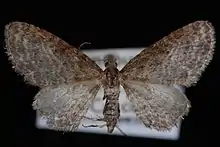Eupithecia olivacea
Eupithecia olivacea is a moth in the family Geometridae first described by Taylor in 1906. It is found in North America from British Columbia south through Washington and Oregon to California.
| Eupithecia olivacea | |
|---|---|
 | |
| Scientific classification | |
| Kingdom: | Animalia |
| Phylum: | Arthropoda |
| Class: | Insecta |
| Order: | Lepidoptera |
| Family: | Geometridae |
| Genus: | Eupithecia |
| Species: | E. olivacea |
| Binomial name | |
| Eupithecia olivacea | |
The forewings are uniform olive brown.[3] Adults are on wing from early March to April.
The larvae feed on Abies grandis, Abies amabilis, Abies lasiocarpa, Crataegus douglasii, Pseudotsuga menziesii var. glauca, Picea sitchensis and Tsuga heterophylla. They have a brown body and head and reach a length of about 20 mm when full grown. There are two morphs. Larvae can be found from April to June and pupation occurs from late June to July. The species overwinters in the pupal stage.[4]
References
- Yu, Dicky Sick Ki. "Eupithecia olivacea Taylor 1906". Home of Ichneumonoidea. Taxapad. Archived from the original on March 25, 2016.
- "910384.00 – 7546 – Eupithecia olivacea – Taylor, 1906". North American Moth Photographers Group. Mississippi State University. Retrieved May 1, 2019.
- McDunnough, James H. (1949). "Revision of the North American species of the genus Eupithecia (Lepidoptera, Geometridae)" (PDF). Bulletin of the American Museum of Natural History. 93: 533–728.
- "Eupithecia olivacea (Taylor)". Trees, Insects and Diseases of Canada's Forests. Natural Resources Canada. Retrieved May 1, 2019.
| Wikimedia Commons has media related to Eupithecia olivacea. |
| Wikispecies has information related to Eupithecia olivacea. |
This article is issued from Wikipedia. The text is licensed under Creative Commons - Attribution - Sharealike. Additional terms may apply for the media files.